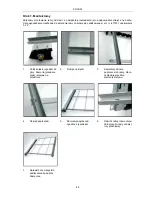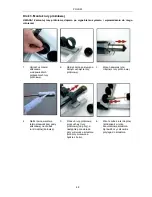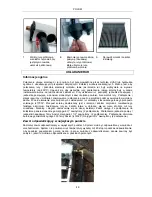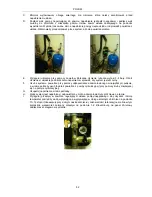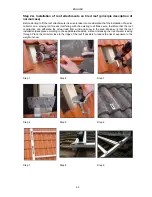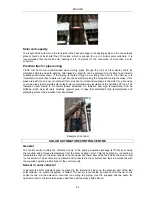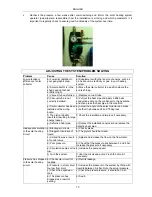
ENGLISH
56
ENGLISH
FUNCTIONAL DESCRIPTION
Vacuum tube
A vacuum tube consists of an outer and an inner glass tube. The glass is made of borosilicate glass,
which has a very high quality and durability. The sunlight is let in through the outer glass and hits an
absorbent surface on the inner tube. When the sunlight hits the absorbent surface the solar radiation is
transformed to heat inside the inner tube. The heat is transferred to the heat pipe via the aluminium
flanges placed inside the vacuum tube (see separate section on heat transfer via heat pipe below).
Between the inner and outer glass tube there is a vacuum, which functions as a highly efficient insulation
from the cold outside. The principle is in other words the same as for a traditional thermos, which is warm
inside but can be cold on the outside. Even on overcast days, when the ultraviolet radiation is stopped by
clouds, the vacuum tube can absorb a certain amount of energy through the existing infrared radiation.
Vacuum tube technology is ideal because of its good insulation for installation in cold climates and by
virtue of its round shape can absorb energy even from side angles and reduce the reflection from the
collector.
Heat pipe technology
Heat pipe technology is not a new phenomena and the aviation industry was quick to use this technology
in aircraft to maintain the temperature balance by temperature transfers, thereby keeping the aeroplane
safe. Nowadays heat pipe technology is common both in computers and air conditioning. Laptop
computers usually use small heat pipes to lead heat away from the processor, and in air conditioning heat
pipe technology is used for heat conduction.
As we know, water has a boiling point of 100°C at sea level. At the top of a high mountain water boils at
less than 100°C, and the higher the elevation, the lower the boiling point. Heat pipe technology makes
use of this principle that water boils at a lower temperature with a reduced air pressure. The heat pipe is
vacuumed and then filled with a small volume of purified water inside, which means that the purified water
achieves a low boiling point of 40°C in these conditions. When the vacuum tube absorbs solar energy
and warms the heat pipe to about 40°C the liquid is vaporised and rises to the top of the heat pipe, i.e.
the condenser. When the heat pipe condenser meets cold water pumped round in the solar heat circuit
the liquid that was vaporised is cooled and sinks down to the bottom of the heat pipe. Heat pipe
technology with liquid circulating in an enclosed circuit enables this process to be repeated over and over
again.
Summary of Contents for 417-031
Page 88: ...SVENSKA 8 Montering av kontrollpanel 1 Montering av bakstycke...
Page 89: ...SVENSKA 9 2 Montering av panel...
Page 94: ...SVENSKA 14 HT Set verhetningsskydd 1 Inst llningar...
Page 100: ...SVENSKA 20 2 Hur man s tter gr sv rdena f r automatiskt l ge...
Page 101: ...SVENSKA 21 3 Hur man ndrar viktiga v rden 4 Anv ndning av knappen...
Page 107: ...NORSK 27 Montering av kontrollpanel 1 Montering av bakstykke...
Page 108: ...NORSK 28 2 Montering av panel...
Page 114: ...NORSK 34 HT Set overopphetingsvern 1 Innstillinger...
Page 120: ...NORSK 40 2 Slik settes grenseverdier for automatisk modus...
Page 121: ...NORSK 41 3 Slik endres viktige verdier 4 Bruk av knappen...
Page 127: ...POLSKI 47 Monta panelu sterowania 1 Monta tylnej cz ci...
Page 128: ...POLSKI 48 2 Monta panelu...
Page 134: ...POLSKI 54 HT Set zabezpieczenie przed przegrzaniem 1 Ustawienia...
Page 140: ...POLSKI 60 2 Spos b ustawiania warto ci granicznych dla trybu automatycznego...
Page 141: ...POLSKI 61 3 Spos b zmiany istotnych warto ci 4 Spos b u ycia przycisku...
Page 147: ...ENGLISH 67 MOUNTING OF CONTROL PANEL 1 Mounting of back...
Page 148: ...ENGLISH 68 2 Mounting of panel...
Page 154: ...ENGLISH 74 HT Set overheating protection 1 Settings...
Page 160: ...ENGLISH 80 2 How to set limiting values for automatic mode...
Page 161: ...ENGLISH 81 3 How to change important values 4 Using the button...




